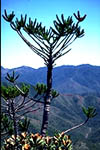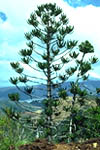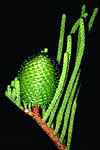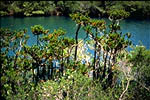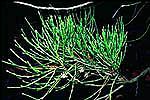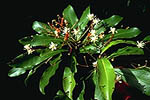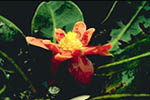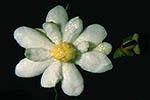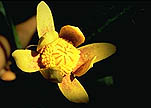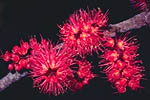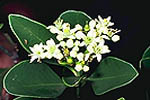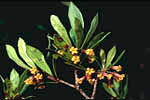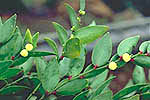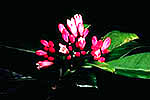 |
QUICK SEARCH
MO PROJECTS:
Africa
Asia/Pacific
Mesoamerica
North America
South America
General Taxonomy
Photo Essays
Training in Latin
America
MO RESEARCH:
Wm. L. Brown Center
Bryology
GIS
Graduate Studies
Research Experiences
for Undergraduates
Imaging Lab
Library
MBG Press
Publications
Climate Change
Catalog Fossil Plants
MO DATABASES:
W³MOST
Image Index
Rare Books
Angiosperm
Phylogeny
Res Botanica
All Databases
INFORMATION:
What's New?
People at MO
Visitor's Guide
Herbarium
Jobs & Fellowships
Symposium
Research Links
Site Map
Search
Diversity, Endemism, and Extinction in the Flora and Vegetation of New CaledoniaOrigin of the New Caledonian FloraNew Caledonia’s flora contains many groups of plants that appear to be remnants of the late Cretaceous - early Tertiary Gondwanan flora that once covered large parts of Australasia. As New Caledonia separated from Australia and drifted to its present position, it carried with it a sample of this early flora. The descendants of these plants have been able to survive in the island's relatively stable climate, while most of their relatives in Australia and other parts of the region were lost due to climatic changes (especially drying) that took place in Neogene times (Holloway, 1979; Kershaw, 1984; Raven, 1980; Raven and Axelrod, 1972, 1974). There are many remarkable examples of relictual endemics in New Caledonia, widely regarded as indicators of the ancient origins of the island's original flora.
Members of New Caledonia’s rich gymnosperm flora. Top row, left to right: Araucariaceae: Araucaria muelleri (Haute Ouinné), A. rulei (Prokoméo), and a female cone of A. scopulorum (Montagne de Poum). Bottom row, left to right: Podocarpaceae: Dacrydium guillauminii (Plaine des Lacs); Cupressaceae: Callitris sulcata (Tontouta River). For example, 43 of the 44 native species of gymnosperms are endemic to the territory (de Laubenfels, 1972), representing almost 7% of the world's total gynmosperm flora (see also Jaffré, 1995).
Primitive flowering plants on New Caledonia. Top row, left to right: Winteraceae: Zygogynum pancheri ssp. ruvulare (Tchamba River, McPherson 5911), Z. baillonii (Montagne des Sources). Bottom row, left to right: Z. cristatum (Mé Ori, McPherson 6135), Z. stipitatum (Mt. Panié, McPherson 5929). New Caledonia also has a very high concentration of primitive flowering plants, including the single species of Amborella (Amborellaceae), and 18 species of Winteraceae (Vink, 1993), an ancient family whose fossil record goes back at least 120 million years, well into the age of the dinosaurs (see also Schatz et al., 1998. Takhtajania perrieri rediscovered. Nature 391: 132-133.).
Examples of early angiosperm groups that survived on New Caledonia. From left to right: Geissois sp. (Cunoniaceae) from Mé Ori; Halfordia kendak (Rutaceae) from Dôme de la Tiébaghi; Pittosporum sp. (Pittosporaceae) on Mt. Mou. Other early groups that have survived on New Caledonia include species of Annonaceae and Chloranthaceae, and primitive members of such families as Arecaceae, Cunoniaceae, Menispermaceae, Monimiaceae (including Atherospermataceae and Trimeniaceae), Piperaceae, Rutaceae, and Sapindaceae (Morat et al., 1984; Raven and Axelrod, 1972). Three of the most primitive genera of Araliaceae also occur on New Caledonia (Lowry, 1986; Oskolski et al., 1997).
Members of groups that reached New Caledonia after it broke off from Australia. From left to right: Phyllanthus sp. (Euphorbiaceae) on Mt. Do; Psychotria sp. (Rubiaceae) on Mt. Dzumac. Many other groups appear to have reached New Caledonia well after it separated from Australia. This took place as part of a widespread movement of Indo-Malesian elements that expanded into Australasia during the early and middle Tertiary (Holloway, 1979; Jaffré et al., 1993; see also below). Some of these newer components speciated intensively, and are now among the largest genera on the island. Examples include Phyllanthus, with 111 species (Schmid, 1991), Psychotria (about 85 species), and Eugenia (around 37 species), among others (cf. Morat, 1993).
|
© 1995-2024 Missouri Botanical Garden, All Rights Reserved
4344 Shaw Blvd.
St. Louis, MO 63110
(314) 577-5100
Technical Support
